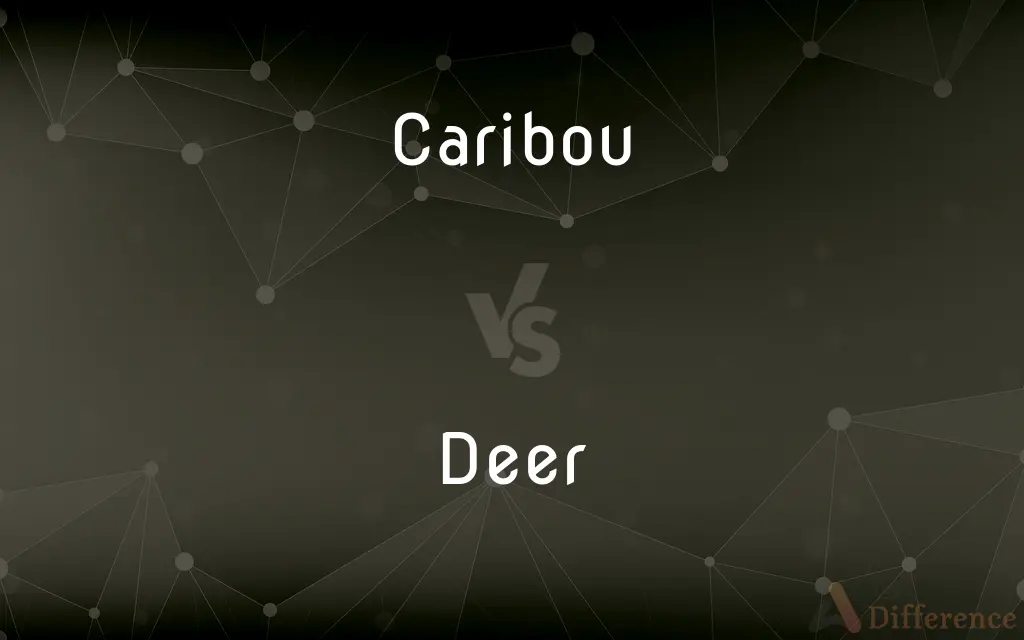Caribou vs. Deer — What's the Difference?
By Tayyaba Rehman — Updated on October 6, 2023
Caribou is a species of large deer found in the Arctic and subarctic regions; deer refers to a broader family of hoofed mammals, which includes species like the whitetail and mule deer.

Difference Between Caribou and Deer
Table of Contents
ADVERTISEMENT
Key Differences
Caribou, recognized for their robust bodies and large antlers, are a specific species within the deer family, native to Arctic and subarctic regions. Deer, conversely, encompasses a wider range of species with varying sizes and habitats.
While both Caribou and deer sport antlers, a notable distinction is that both male and female Caribou grow antlers, whereas in most other deer species, only the males do.
Caribou are migratory animals known for their long treks, traveling hundreds of miles between their summer and winter habitats. While some deer species also migrate, their journeys are typically shorter than those of the Caribou.
The habitats of Caribou are mainly tundras, boreal forests, and mountain regions. In contrast, deer are versatile in their habitats, living in forests, grasslands, swamps, and even urban areas.
Caribou's primary threats come from habitat loss due to climate change and industrial development. Deer, on the other hand, face challenges from habitat fragmentation, vehicle collisions, and hunting.
ADVERTISEMENT
Comparison Chart
Taxonomic Classification
A specific species within the deer family.
A broader family including various species.
Antlers
Both males and females have antlers.
Mostly only males have antlers.
Typical Habitats
Tundras, boreal forests, mountains.
Forests, grasslands, swamps, urban areas.
Migratory Patterns
Long migrations (hundreds of miles).
Some migrate, but typically shorter distances.
Main Threats
Climate change, industrial development.
Habitat fragmentation, vehicle collisions, hunting.
Compare with Definitions
Caribou
A species of large deer native to Arctic and subarctic regions.
The Caribou migrated across the tundra in search of food.
Deer
Known for their agility and keen senses.
The deer detected the slightest sound and bolted into the woods.
Caribou
Known for both males and females sporting antlers.
The female Caribou used her antlers to dig for food in the snow.
Deer
Males of most species grow antlers.
The male deer's impressive antlers caught everyone's attention.
Caribou
Renowned for their extensive migratory patterns.
The Caribou traveled vast distances between their seasonal habitats.
Deer
Can inhabit a variety of ecosystems.
The deer have adapted to life even in suburban areas.
Caribou
Facing threats mainly from climate change.
Shrinking ice patches are a growing concern for the Caribou populations.
Deer
A family of hoofed mammals with various species.
The deer gracefully moved through the meadow.
Caribou
Inhabit tundras, boreal forests, and mountains.
We spotted a herd of Caribou near the edge of the forest.
Deer
Herbivores, primarily grazing on vegetation.
The deer nibbled on the fresh spring grass.
Caribou
A large deer (Rangifer tarandus) of the Arctic tundra and northern boreal forests, having large hooves and long branched antlers. Subspecies native to Eurasia are usually called reindeer.
Deer
Deer or true deer are hoofed ruminant mammals forming the family Cervidae. The two main groups of deer are the Cervinae, including the muntjac, the elk (wapiti), the red deer, the fallow deer, and the chital; and the Capreolinae, including the reindeer (caribou), the roe deer, the mule deer, and the moose.
Caribou
Any of several North American subspecies of the reindeer, Rangifer tarandus.
Deer
Any of various hoofed ruminant mammals of the family Cervidae, characteristically having deciduous antlers borne chiefly by the males. The deer family includes the white-tailed deer, elk, moose, and caribou.
Caribou
The American reindeer, especially the common or woodland species (Rangifer Caribou).
Deer
A ruminant mammal with antlers and hooves of the family Cervidae, or one of several similar animals from related families of the order Artiodactyla.
Caribou
Arctic deer with large antlers in both sexes; called reindeer in Eurasia and caribou in North America
Deer
(in particular) One of the smaller animals of this family, distinguished from a moose or elk
I wrecked my car after a deer ran across the road.
Deer
The meat of such an animal; venison.
Oh, I've never had deer before.
Deer
Any animal, especially a quadrupedal mammal as opposed to a bird, fish, etc.
Deer
Any animal; especially, a wild animal.
Mice and rats, and such small deer.
The camel, that great deer.
Deer
A ruminant of the genus Cervus, of many species, and of related genera of the family Cervidæ. The males, and in some species the females, have solid antlers, often much branched, which are shed annually. Their flesh, for which they are hunted, is called venison.
Deer
Distinguished from Bovidae by the male's having solid deciduous antlers
Common Curiosities
Which animal has both males and females with antlers?
Both male and female Caribou have antlers.
Do all deer species live in the Arctic?
No, only Caribou are native to the Arctic; other deer species live in various habitats.
Are deer limited to forest habitats?
No, deer can inhabit forests, grasslands, swamps, and even urban areas.
What is a major threat to Caribou?
Climate change and industrial development are primary threats to Caribou.
Are Caribou a type of deer?
Yes, Caribou are a specific species within the deer family.
What's a young deer called?
A young deer is often referred to as a fawn.
Which deer species can you find in urban areas?
Some species, like the whitetail deer, can be found in urban settings.
How do deer communicate?
Deer use vocalizations, body language, and scent marking to communicate.
How do deer adapt to different habitats?
Deer are versatile and can adjust their diet and behavior based on their environment.
Are Caribou hunted like other deer species?
Yes, Caribou are hunted, but regulations and reasons might differ based on regions and indigenous practices.
Are all deer migratory like Caribou?
While some deer species migrate, their journeys are typically shorter than Caribou's.
Why do Caribou migrate such long distances?
Caribou migrate to find food and suitable habitats as seasons change.
Is the meat of Caribou and other deer eaten?
Yes, both Caribou and other deer species are hunted for their meat, often called venison.
Are Caribou antlers different from other deer antlers?
Caribou antlers can be broader and more shovel-like, but their main uniqueness is that both genders grow them.
Do Caribou and deer have predators?
Yes, both Caribou and deer have predators like wolves, bears, and mountain lions.
Share Your Discovery

Previous Comparison
Burlesque vs. Vaudeville
Next Comparison
Process vs. MethodAuthor Spotlight
Written by
Tayyaba RehmanTayyaba Rehman is a distinguished writer, currently serving as a primary contributor to askdifference.com. As a researcher in semantics and etymology, Tayyaba's passion for the complexity of languages and their distinctions has found a perfect home on the platform. Tayyaba delves into the intricacies of language, distinguishing between commonly confused words and phrases, thereby providing clarity for readers worldwide.














































